"Buy land, they aren't making any more of it." This is a quote often mistakenly attributed to Mark Twain in the 20th century, frequently used as a slogan in the real estate sales sector. Gravity strongly endorses this statement; if humanity cannot achieve interstellar travel, land is as "non-inflatable" as Bitcoin.
In 2025, the crypto wave spread from Silicon Valley to Wall Street and eventually impacted Washington. As compliance gradually progressed, it began to quietly change the fundamental structure of the real estate industry. In early July, Christie's International Real Estate officially established a dedicated department for crypto property transactions, becoming the world's first mainstream luxury real estate brokerage brand to fully support "pure cryptocurrency payments for home purchases."
And this is just the beginning. From Silicon Valley entrepreneurs to Dubai developers, from luxury homes in Beverly Hills, Los Angeles, to rental apartments in Spain, a number of property trading platforms centered around blockchain technology and digital assets are emerging, forming a new "Crypto Real Estate" track.
Why Crypto Can Drive the Next Wave of U.S. Real Estate
The value of U.S. real estate reached nearly $50 trillion in 2024, making it one of the most significant asset markets globally. This figure was about $23 trillion a decade ago in 2014, meaning the asset scale in this sector has doubled in ten years.
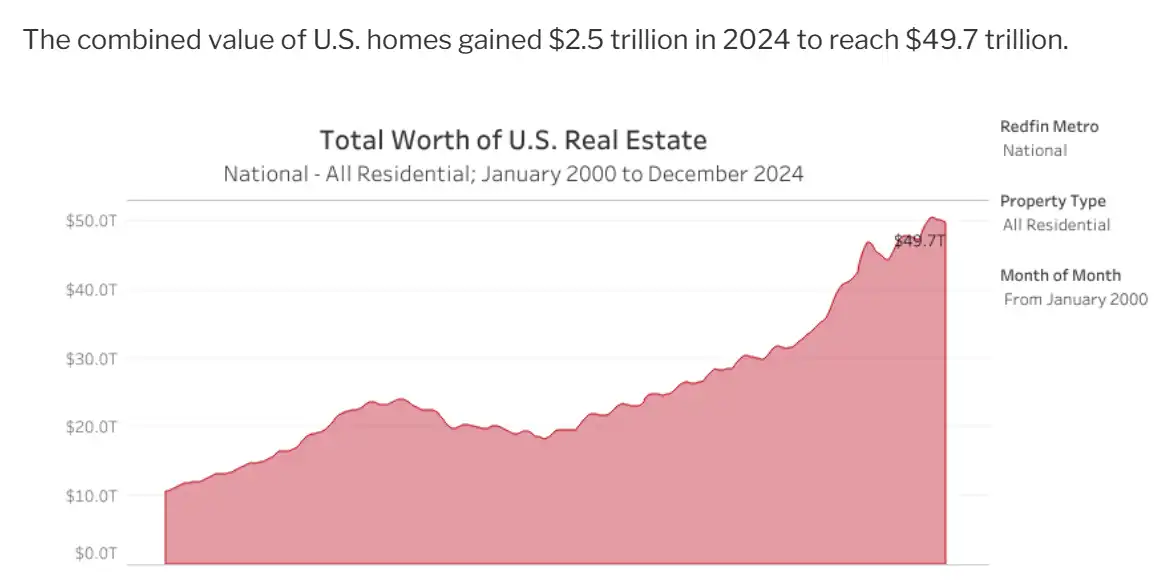
Overall U.S. real estate volume, Awealthofcommonsense analysis report
In June 2025, the NAR report indicated that the median home price in the U.S. reached $435,300, a 2% increase from the same period last year. The housing inventory was about 1.53 million units, with a supply-demand ratio of 4.7 months. High home prices and long-term supply shortages have raised the entry barrier, coupled with persistently high mortgage rates (the average 30-year fixed rate was about 6.75% in July 2025, while Bitcoin mortgages are currently around 9%), which consistently exceed the annual appreciation of property values. This has suppressed transaction volumes, and low liquidity has led property investors to seek new sources of liquidity.
However, high rates are not just blocking the low liquidity issue for real estate investors. Over the past five years, the average wealth of property owners has increased by $140,000. Yet, many families are reluctant to leverage their real estate assets for liquidity because their monetization paths generally consist of only two options: selling the entire asset or renting it out. Leveraging property in the current interest rate environment does not seem like a good choice, and selling amid rising home prices also does not appear to be a better investment decision.
Thus, in the overall $50 trillion real estate sector, about 70% of the equity (approximately $34.98 trillion) is owned by holders, meaning only 30% is supported by borrowed funds, with the rest being the buyers' own capital. For example, a family owns a property worth $500,000; although nominally they own this property, if they want to sell it, they need to deduct the portion of the loan to determine their actual ownership. In the case of 70% equity, they own $350,000 of equity in that property.
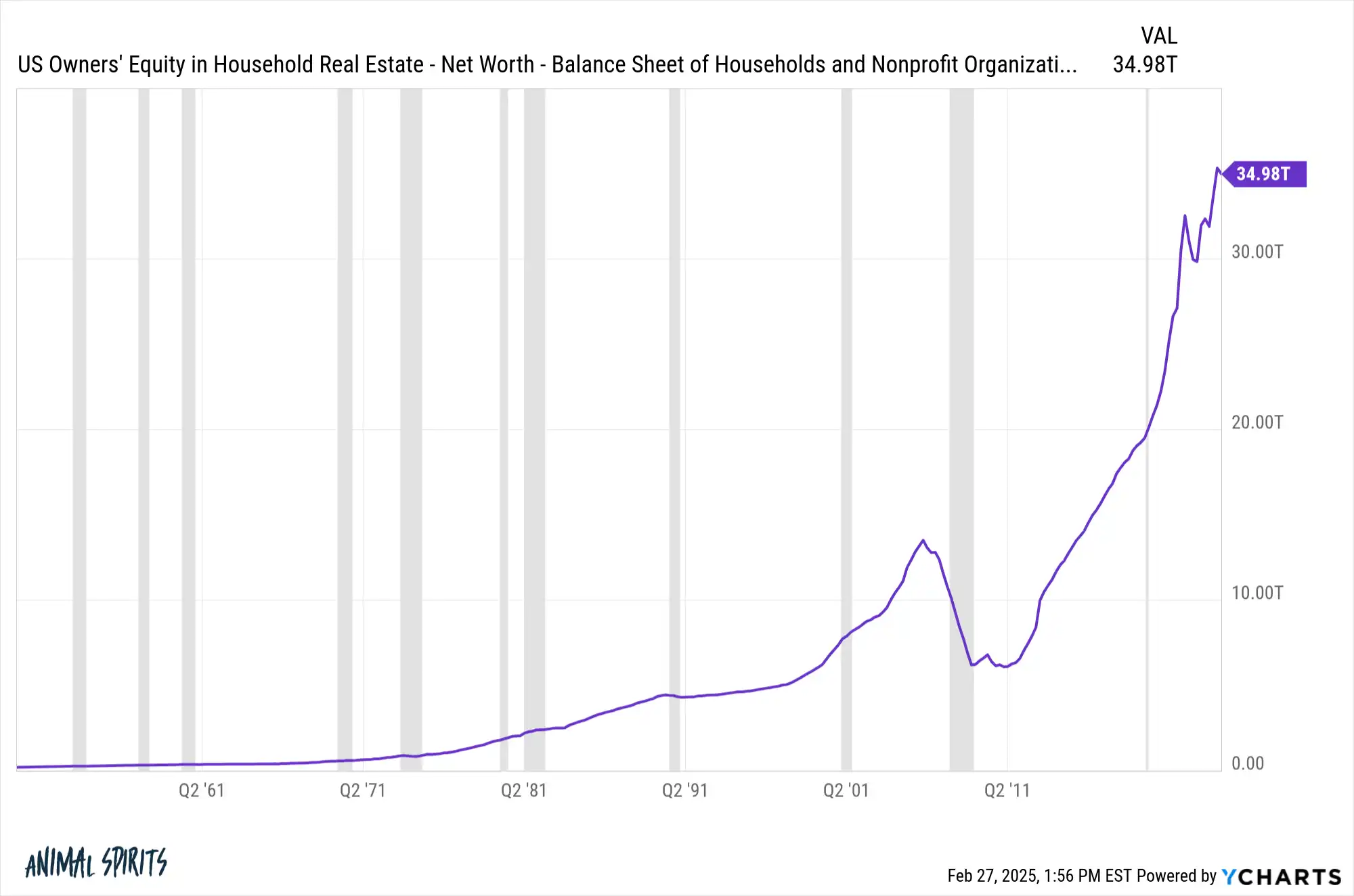
U.S. real estate equity holdings, source: Ycharts
However, merely having a supply-demand relationship is far from sufficient. The concept of RWA has been developing for many years but has only truly exploded in the past two years, especially after Trump's election in 2025, which further increased the upward slope.
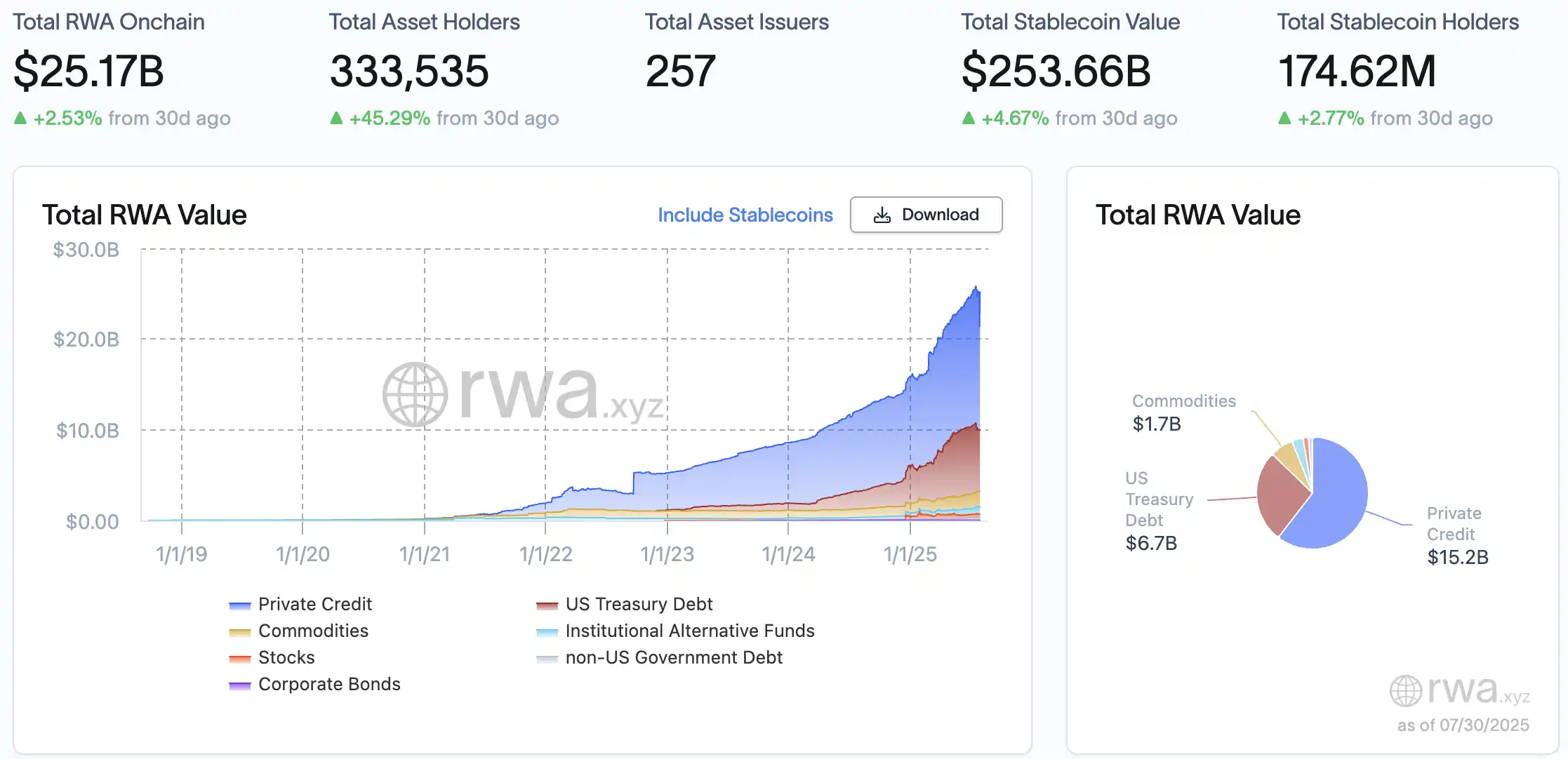
Its core is compliance, especially for investors in low-liquidity assets like real estate. In March 2025, the new FHFA director, William Pulte, ordered mortgage giants Fannie Mae and Freddie Mac to develop plans allowing crypto assets to be included as reserve assets when assessing single-family mortgage risks, without needing to convert them into dollars first. This policy encourages banks to view cryptocurrencies as countable assets in savings, expanding the borrower base.
In July 2025, Trump signed the GENIUS Act and promoted the CLARITY Act. The GENIUS Act officially recognizes stablecoins as legal digital currencies, requiring stablecoins to be fully backed 1:1 by safe assets like dollars or short-term government bonds and mandating third-party audits. The CLARITY Act aims to clarify whether digital tokens are securities or commodities, providing a regulatory path for practitioners.
These sets of measures provide a greater margin of safety in the field, and the scarcity attribute of real estate, similar to Bitcoin's "non-inflatable" nature (land cannot increase, but properties can; building houses is like mining), makes it easier for the two to combine. Digitization helps break down high barriers. One of the Big Four accounting firms, Deloitte, predicts in its financial sector report that by 2035, about $4 trillion of real estate could be tokenized, far exceeding the less than $300 billion in 2024.
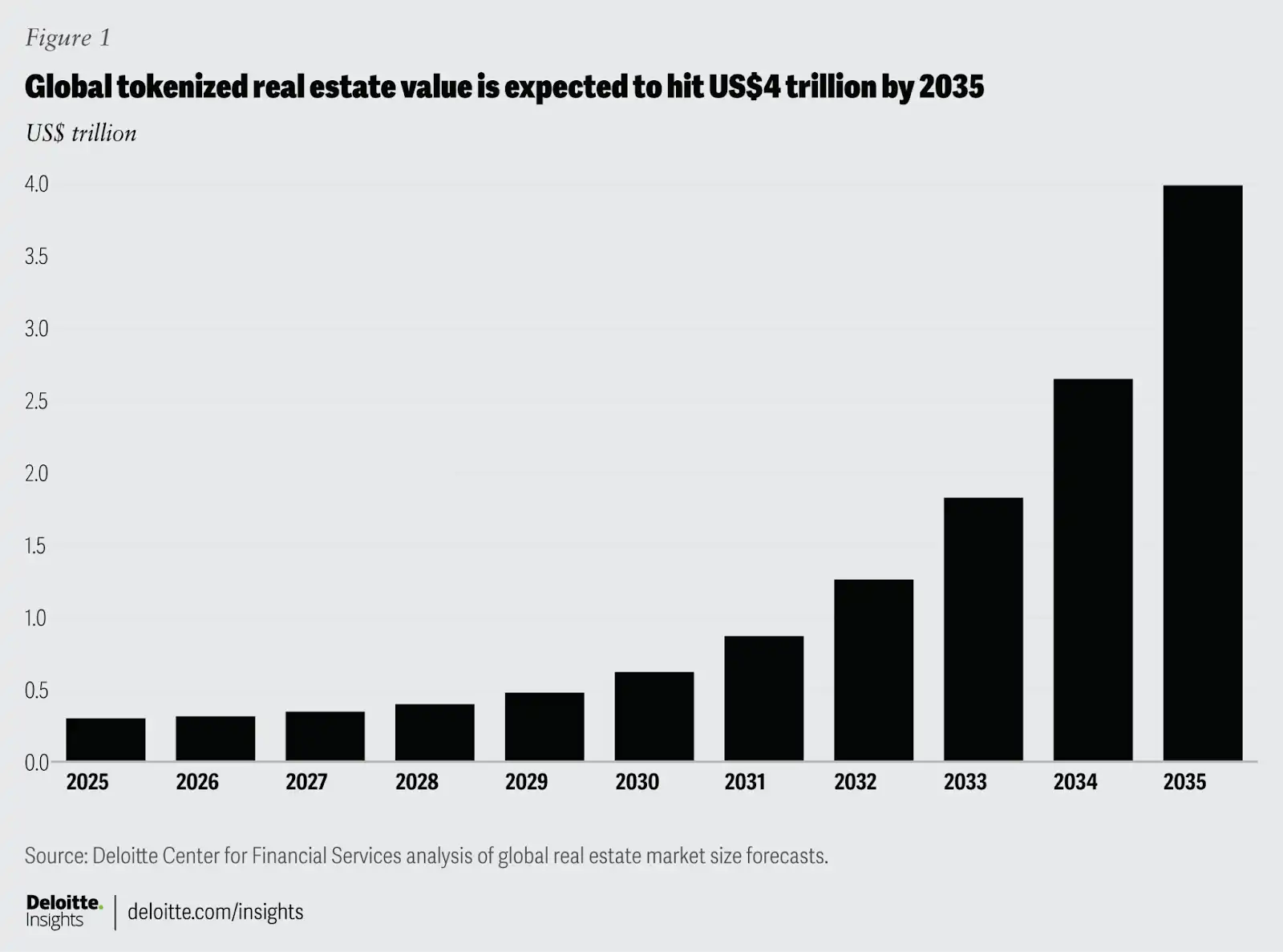
Tokenization can break large real estate into smaller shares, providing global investors with a low-barrier, high-liquidity way to participate, while also creating cash flow for sellers and buyers who originally lacked funds. That said, while the $4 trillion figure sounds appealing, it is debatable, much like institutional predictions that ETH's market cap will reach $85 trillion in the future. But how far has it actually developed? We may find some Alpha in the market.
Fragmentation? Lending? Renting? Providing liquidity? Playing real estate like DeFi
Unlike other low-liquidity physical assets like gold and art, real estate inherently carries financial attributes. Its connection to crypto has diversified these attributes even further.
Although there have been attempts in the past, the collaboration between the Harbor platform and RealT in 2018, which launched blockchain-based real estate tokenization services, is considered one of the earlier and more substantial real estate tokenization projects.
Specifically, the RealT platform splits property rights into tradable RealTokens via blockchain. Each property is held by an independent company (Inc/LLC), and investors purchasing RealTokens effectively hold a portion of the company's shares and proportionally enjoy rental income. The platform utilizes Ethereum's authorized issuance mechanism, lowering the investment threshold (usually around $50), and both transactions and rental distributions are completed on-chain, relieving investors from the daily management tasks of traditional landlords. RealT distributes rental income weekly to holders in stablecoins (USDC or xDAI).

The expected returns come from the net asset return rate (RONA), which is the annual net rent divided by the total property investment. For example, if the expected annual rental income for a property, after expenses, is $66,096, and the total investment is $880,075, then the RONA is 7.51%. This figure does not include leverage or property appreciation returns. Currently, the platform's average yield fluctuates between 6% and 16%.

After tokenization, the next step is naturally to apply it. RealT's properties have no loans; all funds come from the sale of RealTokens. However, to allow holders to flexibly utilize their assets, RealT launched the RMM (Real Estate Money Market) module.
RMM is based on the Aave protocol, allowing you to do two things: first, provide liquidity, similar to LP interest in DeFi, where investors can deposit USDC or XDAI into RMM and receive corresponding ArmmTokens, which accumulate interest in real-time. Second, you can borrow by collateralizing RealTokens; you can use your RealTokens or stablecoins as collateral to borrow assets like XDAI. There are also two borrowing rate options: a stable rate (similar to a short-term fixed rate but adjusts when utilization is too high or rates are too low) and a variable rate (fluctuating based on market supply and demand).
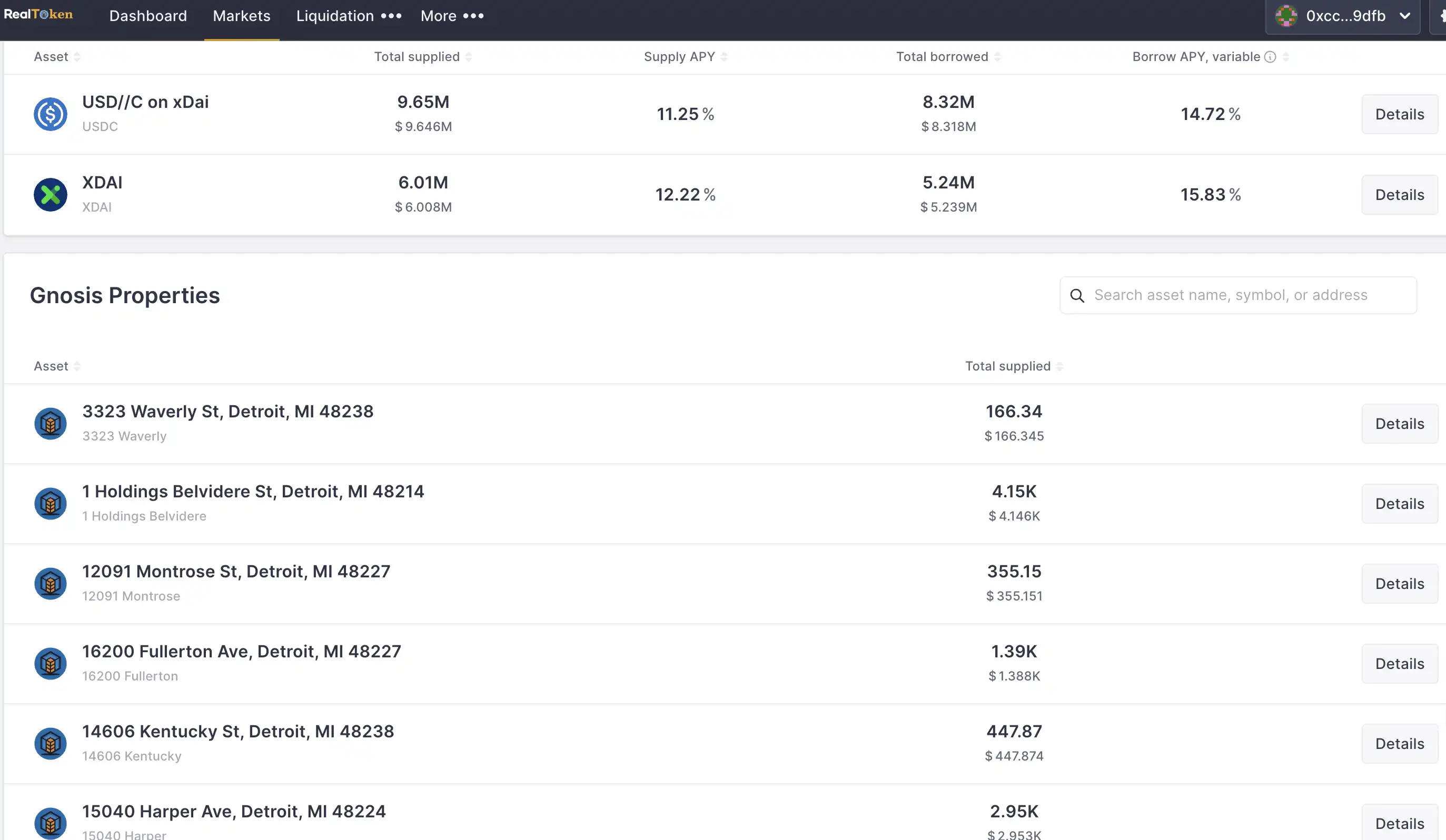
Opening up this lending pathway means leveraging, much like how property speculation groups borrowed money to buy houses years ago, using mortgage loans to buy more houses. Collateralizing RealTokens to borrow stablecoins and then purchasing RealTokens again, repeating this process multiple times to increase overall return rates. It is important to note that with each additional layer of leverage, the health factor decreases, and risk increases.
Note: The health factor is the inverse ratio of the collateral value to the loan value; the higher the health factor, the lower the liquidation risk. When the health factor drops to 1, it means the collateral value equals the loan value, which may trigger liquidation. Ways to avoid liquidation include repaying part of the loan or adding more collateral (similar to margin in perpetual contracts).
In addition to using real estate as "collateral" for loans, there has been increasing discussion about using native crypto assets for mortgage lending to buy homes. Financial technology company Milo allows borrowers to use Bitcoin as collateral to obtain mortgages with up to 100% loan-to-value ratios. As of early 2025, it has completed $65 million in crypto mortgage transactions, with total loans exceeding $250 million. Policy-wise, this model is being "greenlit," as the Federal Housing Finance Agency (FHFA) requires mortgage giants Fannie Mae and Freddie Mac to consider compliant crypto assets in their risk assessments. Although the interest rates for crypto mortgages are generally close to or slightly higher than traditional mortgages, their main attraction lies in the ability to finance without having to sell crypto assets.
Further reading: "Bitcoin Mortgages: A $6.6 Trillion New Blue Ocean"
A survey by Redfin shows that about 12% of first-time homebuyers in the U.S. used cryptocurrency gains for down payments (from sales or mortgage loans) after the pandemic. Coupled with the shift in policy direction, this will undoubtedly attract "big players" into the market, and "Crypto Real Estate" is also seeing the entry of high-end real estate economic companies for the first time.

In July 2025, Christie's International Real Estate became the first to establish a luxury real estate division focused on cryptocurrency, marking a significant case of integration between traditional high-end real estate brokerage and digital assets. Interestingly, this move was not driven by a top-down strategic push but was a response to the genuine needs of high-net-worth clients.
Christie's executives stated, "An increasing number of wealthy buyers want to complete property transactions directly with digital assets, prompting the company to build a service framework that supports full-process crypto payments." In Southern California, Christie's has completed multiple luxury home transactions entirely paid for with cryptocurrency, totaling over $200 million, all involving "eight-figure" high-end residences. Currently, Christie's portfolio of crypto-friendly properties is valued at over $1 billion, encompassing numerous luxury homes willing to accept "pure cryptocurrency offers."

One of the properties accepting pure cryptocurrency payments, valued at $118 million, "La Fin," is located in Bel-Air, Los Angeles. It features 12 bedrooms, 17 bathrooms, a 6,000-square-foot nightclub, a private wine cellar, a sub-zero vodka tasting room, a cigar lounge, and a gym with a climbing wall. The previous listing price was as high as $139 million. Source: realtor
Christie's crypto real estate division not only provides payment channels based on mainstream crypto assets like Bitcoin and Ethereum but also collaborates with custodians and legal teams to ensure transactions are completed within a compliant framework. This includes crypto payment custody, tax and compliance support, and asset matching (exclusive crypto property portfolios that meet the specific investment needs of high-net-worth clients).
Aaron Kirman, CEO of Christie's Real Estate, predicts, "In the next five years, more than one-third of residential real estate transactions in the U.S. may involve cryptocurrency." Christie's transformation indirectly confirms the penetration of crypto assets among high-net-worth individuals and signals a structural change in traditional property transaction models.
Infrastructure is improving, but it seems that "user" education still has a long way to go
As of now, real estate tokenization projects have begun to take shape, but they seem to fall short of their expected standards. RealT has tokenized over 970 rental properties, generating nearly $30 million in pure rental income for users; Lofty has tokenized 148 properties across 11 states, attracting about 7,000 monthly active users who share approximately $2 million in annual rental income through token ownership. The scale of several projects hovers around tens of millions to hundreds of millions, and the inability to break through may have multiple reasons.
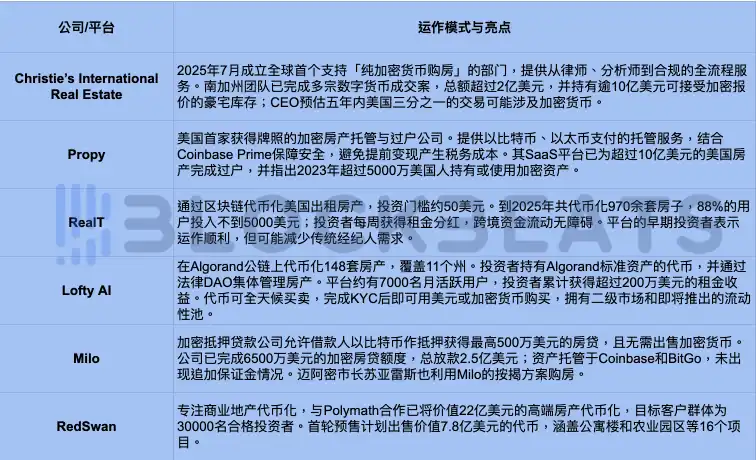
On one hand, blockchain indeed allows transactions to break free from geographical limitations, enabling cross-border instant settlements, and the transaction fees are lower compared to traditional property transfer costs. However, investors need to understand that this is not a "zero-cost" ecosystem: token minting fees, asset management fees, transaction commissions, network fees, and potential capital gains taxes constitute a new cost structure. Compared to the "one-stop service" provided by traditional real estate agents and lawyers, crypto real estate requires investors to actively learn and understand smart contracts, on-chain custody, and crypto tax rules.
On the other hand, while liquidity is a selling point, it comes with higher volatility. Tokenized properties can be traded around the clock in secondary markets, allowing investors to receive rental income and exit their positions at any time. However, when liquidity is insufficient, token prices may be far above or below the actual valuation of the property itself, with market fluctuations potentially outpacing the cycles of physical real estate, increasing the speculative nature of short-term trading.
Additionally, many platforms introduce DAO (Decentralized Autonomous Organization) governance, allowing investors to vote on matters such as rent and maintenance. This sense of participation is similar to "playing Monopoly," lowering the barriers and enhancing interactivity, but it also places new demands on users: they must not only understand property management but also possess awareness of on-chain governance and compliance. In the absence of sufficient education, investors may misjudge risks, viewing digital real estate as a short-term arbitrage tool rather than a long-term asset allocation.
In other words, the real barrier to crypto real estate lies not in technology but in cognition. Users need to understand concepts such as collateral ratios, liquidation mechanisms, on-chain governance, and tax reporting, which represents a disruptive shift for those accustomed to traditional home-buying models.
As regulation becomes clearer, platform experiences improve, and mainstream financial institutions get involved, the future of crypto real estate is expected to shorten this educational curve. However, in the foreseeable years, the industry still needs to invest more resources in user training, risk control education, and compliance guidance to truly transition "crypto real estate" from a niche experience to widespread adoption.
免责声明:本文章仅代表作者个人观点,不代表本平台的立场和观点。本文章仅供信息分享,不构成对任何人的任何投资建议。用户与作者之间的任何争议,与本平台无关。如网页中刊载的文章或图片涉及侵权,请提供相关的权利证明和身份证明发送邮件到support@aicoin.com,本平台相关工作人员将会进行核查。




